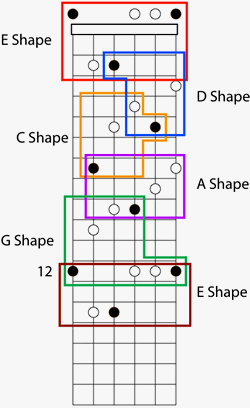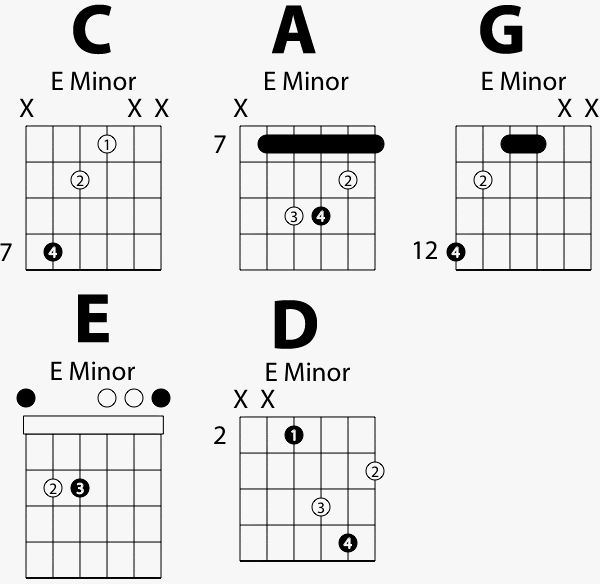Welcome to this lesson. We are going to take what we learned in the lesson about the CAGED chord sequence and apply it to minor chords instead of major ones. The CAGED sequence can be applied to minor chords just like you applied it to major chords. If you don’t know the minor chord shapes presented in this lesson that’s okay, we have supplied you with the diagrams. Once you learn the minor chord shapes we will put them in the CAGED sequence to give you a greater understanding of how the guitar fretboard is laid out. We will be in the key of E minor for this lesson so all of the chords in the CAGED sequence will be E minor chords.

The five minor chord shapes that we will be using are the fundamental shapes for a lot of minor chords. Start on the E of the CAGED sequence by playing a regular open E minor chord.
The second chord in the CAGED sequence is D make an E minor chord using the D minor chord shape. Place your 1st finger on the 2nd fret of the 4th string, 2nd finger on the 3rd fret of the 1st string, 3rd finger on the 4th fret of the 3rd string and 4th finger on the 5th fret of the 2nd string.
C is the next chord in the sequence. Make an E minor triad by placing your 3rd finger on the 7th fret of the 5th string, 2nd finger on the 5th fret of the 4th string and 1st finger on the 4th fret of the 3rd string. Play those three notes.
Make an E minor chord using the A minor bar chord shape for the fourth chord in the sequence. Odds are your probably already know this shape. If you don’t, just check out the chord diagram.
The last chord in the CAGED sequence is a G so lets make an E minor chord based off of a G minor shape. Place your 4th finger on the 12th fret of the 6th string, 2nd finger on the 10th fret of the 5th string and make a bar across the 9th fret of the 3rd and 4th strings. Play those four notes.
Round out the sequence by coming back to the E shape and playing an E minor bar chord with your bar on the 12th fret and your 3rd finger on the 14th fret of the 5th string and your 4th finger on the 14th fret of the 4th string.
Start over on the first E minor chord that you played and try to visualize the next shape in the sequence before you take that open E minor chord off to move to the D minor shaped E minor chord. Try to do this all the way up the sequence. It is very important that you visualize where the next chord shape is before you try to move to that next chord. It is also very important that you try to visualize and be aware of where all of the root notes of the chords are. In this case those notes will be all E notes. We have included a diagram of the fretboard with all of the E minor chords in the CAGED sequence. All of the E notes are in black so that you can easily see where all of the root notes for the chords are.
Try going through the CAGED sequence for every minor key that you can think of. You don’t have to wear yourself out on this stuff but do try to make it a part of your regular practicing to some extent. Have fun and play more guitar!


